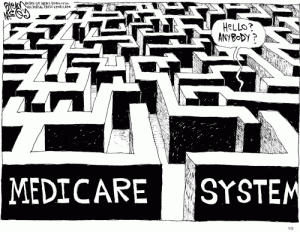The second part of WOW (see last weeks post) will return next week. I came across an article in Senior Housing News that talks about changes in Medicare payments to skilled nursing facilities instituted in 2010. According to Medicare, the changes were designed to be revenue neutral, which of course raises the question why bother even making the change. However, it turns out the changes will result in an increase in payments to nursing homes of some $4 billion in 2011.
After reading the report behind the article I find myself shaking my head in wonder. . . . Do the people who create and administer the Medicare reimbursement system have any understanding as to why people operate senior housing and health-care communities? Do they really not get that people invest tens of million dollars in buildings and operations to make a profit? Do they really not get that even successful not-for-profits follow the maxim, “no margin, no mission”? Since Medicare was signed into law in 1965 it has been a cat and mouse game where the providers’ goal has been to make as large a profit as possible while the Federal government attempts to fairly replace a market forces system, with one that provides adequate medical care for seniors and provides reasonable/fair payment for those services. The problem is that consistently, providers are smarter, or at least more nimble, and in some cases, better politically connected, allowing them to profit handsomely from the system. The end result has been an astonishing increase in the cost of health care. It seems that every time Medicare makes a change in the rules, providers quickly figure out how to work within those rules, to at least stay even and often improve profitability. T
his most recent change that resulted in increased costs makes me ask: “What were they thinking?” Any first year business school undergraduate would have been able to look at the rule changes and quickly see that they could only result in increased costs. The problem is compounded by the craziness of individual state reimbursement systems that result in wildly different reimbursement rates for the same level of care. Often these disparities do not accurately reflect geographical disparities in “costs of living” or “costs of care”. Perhaps the Federal government needs to look at how Senior HMO’s operate.
These private payers operate in a perpetual environment of competing interests that include: providing for the health needs of their customers, staying out of trouble with regulators and making a profit. It means they have to create a balance and be creative in their case management. While they operate by a set rules or policies, they are able to be flexible and creative allowing for exceptions to achieve the goal of profits and reasonable patient care. This might mean, for example, that a resident would be placed in an assisted living community rather than a skilled nursing community. I predict the next set of changes designed to fix this problem will generate more paperwork and more processes which will further add to the administrative costs of providing care and in the end, the costs will continue to increase. This is the most frustrating and most curious aspect of the reimbursement game; Why do they think that by requiring health care providers to do more paperwork, to provide deeper piles of documentation, to hire more people, who do nothing more than fill out forms and file reports, that the quality of care will improve and that there will be fewer abuses? As near as I can tell, the only real impact has been to spend scarce funds on non-resident care staff, to the detriment of the residents themselves. Rant over! Steve Moran Image Source: Slate








